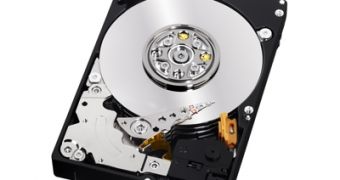Western Digital has officially announced the S25 series of hard disk drive units, where the Serial Attached SCSI interface meets the 10,000 rotations per minute (RPM) spindle speed.
From the interface alone, it is easy to gleam that this series is intended for business and enterprise applications rather than consumers.
The SAS 6.0 Gbps interface has 32 MB of cache memory to work with, as well as a 204 MB/s buffer to disc transfer rate and 7.8W read/write power consumption.
Also, as the third generation of SAS HDDs, they are also the first of their kind to support T10 protection information (PI), which implies a more advanced data integrity.
"Continuing our commitment to the industry's fastest-growing segment - 2.5" drives - WD is updating our small form factor SAS offering with the advanced technology of our third-generation drive, including a new 900 GB capacity point," said Darwin Kauffman, vice president of enterprise storage solutions at WD.
Since we are on the subject of capacity, there are four members in the SAS 6.0 Gbps series, of 300 GB, 450 GB, 600 GB and 900 GB, respectively.
All of them are shipping to OEMs, but mass availability isn't expected until later in the third quarter of the year (2012).
Online transaction processing and multi-tiered storage arrays are the primary sales outlets and, to reflect the need for long-term assurance of stability, WD offers a 5-year warranty.
Unfortunately, just how much money WD asks in exchange for each S25 unit remains a mystery.
"Our latest generation of WD S25 SAS drives offer a powerful combination of enterprise-class performance and industry-leading reliability that is ideal for demanding high-performance computing and mission-critical environments. WD is also delivering higher capacity offerings and the power efficiency of the small form factor footprint, providing the most efficient storage solution for IT professionals and enabling lower TCO (Total Cost of Ownership)," added Mr. Kauffman.

 14 DAY TRIAL //
14 DAY TRIAL //